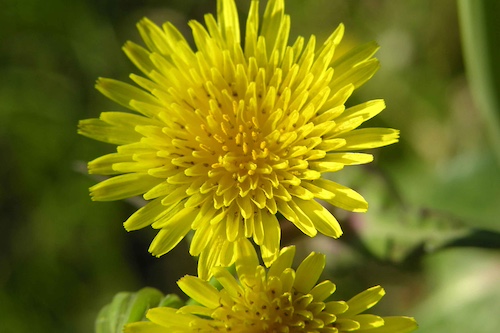(Sow thistle)
I live on an island that has about 1500 different flowers, but I only can recognize a handful of them: like anemones, poppies, mallow, rockroses, orchids and dandelions (Taraxacum officinale). In the past weeks I have been baffled to see a neighbouring dandelion shooting, rocket-like into the sky. It has now reached a height of more than two meters. But not all yellow flowers are dandelions. There also are false dandelions. Yellow flowers with petals like lion’s teeth. Stems and leaves however can be quite different.
Bedwetters
When I was a child I used to make wine with dandelions: a glass of water with the flowers of dandelions becomes yellow after some time. With a bit of imagination you were drinking ‘wine’ (the recipe of real dandelion wine is a bit more complicated). I cannot remember if after such a drinking party I peed my bed, or not — because dandelions are known for their diuretic properties. Flemish children will be warned because in Belgium dandelions are called beddepissers (bedwetters), similarly in France: pissenlit. While in many languages the dandelion has been named after the French word for lion’s teeth: dents de lion or dandelion. In German it is (Gewöhnlicher) Löwenzahn.
Dandelion latex
I used to be an enterprising child who, along with friends, built playgrounds; thus earning some pocket money. If only I then had known that the hollow stems of dandelions produced a kind of latex, I would have been a rich woman. In the Second World War they even used it to make rubber tires for cars. And even today there is research into how to harvest dandelion latex for a reasonable price. But for the moment all we can do is eat dandelions for their blood cleaning properties and as a vitamin bomb full of minerals.
Now that the anemones have said goodbye and the red poppies are starting to fade, the colour yellow dominates the landscape. Not because of the dandelions who also have ended their blooming season — it’s the members of the community of the false dandelions, like the sow thistle (Sonchus) that try to fool you these days.
Minotaur
Succesfully. Even in Greek mythology they were mixed up. In the myth of Theseus, who killed the Minotaur, the monster that was half bull-half man lived in a labyrinth on Crete and was fed with human flesh and once a year with that of young Athenians. Theseus, son of an Athenian king, decided to finish this bloodshed and to kill the monster. For three weeks he ate dandelions to get stronger. With help of the famous thread of Ariadne he succeeded in killing the Minotaur. Or was it thanks to the dandelions? In another version of this myth Theseus ate sow thistles to get stronger.
Sow thistle
The sow thistle is an overgrown dandelion with pointy sharp leaves. Some weeks ago Lesvos (and a great part of Greece) was besieged by sand from the Sahara and I wonder if the sow thistles used that dust as multivitamins, because since then they have shot unusually high towards the sun.
In their long and branched stems sow thistles also hide a watery latex kind of stuff, giving the stems an acidic taste; so sour that you’d better do not put them in a salad. Contrarily, their young leaves are pretty tasty and full of healthy vitamins. The plant however is not used as raw material to make sexy latex cloths or car tires.
Dandelion fluffs
As a child I used to play with the fluffy seed balls of the dandelions, which sow thistles also have. If you blew off all the seeds in one blow, you would be lucky in your love life.
How did someone come up with the idea of hanging flower seeds under a parachute-like collection of fluffs? Might it be the invention of Apollo? He loved to race with chariot and horses across the heavens, causing whirling clouds of dust. It is said that when the dust kissed the earth it created dandelions. It may be that those whirling clouds of dust trained the dandelion seeds to become great flyers: they can easily be taken by the wind as far as three kilometers. As a child I also tried to fly but I never looked to dandelion seeds for advice. However, nowadays their artistry in flying has inspired scientists to make better flying drones.
I had no knowledge of this as a child. In my young years there only was dandelion wine from real dandelions. Here on Lesvos it’s the false dandelions that are partying, after the lion’s teeth have lost all their fluff. I wonder if they too can make a good wine.











